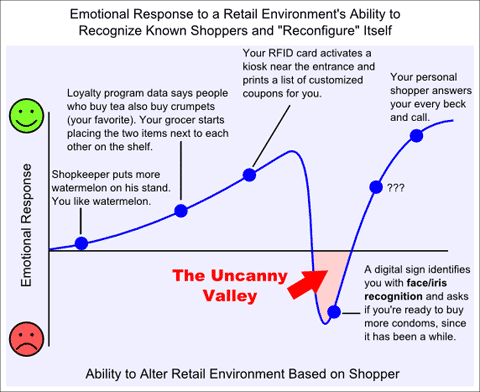Should you be worried about who's watching you?
Where do we draw the line? Well, I've been getting calls and emails from tech vendors, journalists and privacy advocates asking what kinds of services can be offered at retail to help the shopper without seeming pushy, creepy, or violating their privacy. I let these requests stack up for a while now because, quite frankly, I just don't know. After thinking it over some more, I put together this chart to help illustrate the challenge:

Worried yet? Yeah, me too, a little. But let's take a step back and consider how the whole idea of the Uncanny Valley came to be, and how this relates to privacy and personalization.
When machines become too much like us: Exploring the "Uncanny Valley"
Back in the 1970s, sci-fi was entering mainstream culture and the field of robotics was just getting off the ground. In this early period, Japanese roboticist Masahiro Mori first described the Uncanny Valley. As Wikipedia tells us, "When robots and other facsimiles of humans look and act almost like actual humans, it causes a response of revulsion among human observers. The 'valley' in question is a dip in a proposed graph of the positivity of human reaction as a function of a robot's lifelikeness." Basically, the more human-like something tries to appear or act, the more we scrutinize its non-human characteristics. This is the effect that allows It's Christmas, Charlie Brown! to be cute and endearing, but makes The Polar Express seem creepy and... well, creepy. But...
How are new technologies influencing marketing and consumer privacy?
As I started thinking about this, I discovered that Seth Godin already had it all figured out. As usual, Seth also explained the issue more eloquently (and less loquaciously) than I could:
We love cute dogs, cute monkeys, clairvoyant websites, smart voice mail systems.How can you navigate this environment -- and what's the upside?
But we get totally wigged out when a website knows too much about us, when we start talking to a voice mail attendant like she's a real person or when a photo or a robot is just too good. A magician is fine, an actual mind reader we burn at the stake.
The relevant issue here for marketers is what happens when our databases and predictions get too good. I don't want the hotel to automatically serve me the same breakfast that I ordered during my last trip, or for the doorman to pretend he's my friend just because he read a database entry about me.
The Uncanny Valley begins and ends in different spots for me than it does for you. Heck, you might even have liked The Polar Express for all I know. But ensuring that marketers don't overstep their bounds and shoppers continue to trust and enjoy their retail experiences is going to require a real, ongoing dialog between those that sell products and those that buy them. This will have to go beyond mere disclosure of surveillance practices or robust opt-in and opt-out policies, though those will certainly need to exist and be enforced too. But there's real upside to be had, if the graph above is to be believed. At some level of personalization, we ought to be able to get through the valley and deliver higher levels of service that people will genuinely appreciate. While personal shoppers are probably going to be off-limits to all but the super rich for the near future, there may be some low-cost, low-touch method out there that gets past the valley, boosts sales or loyalty for retailers, and leaves shoppers with a warm, fuzzy feeling all at once.
Where does your Uncanny Valley begin? What in-store technologies are you looking forward to as a shopper, and which ones do you think are just plain creepy?


 Subscribe to the Digital Signage Insider RSS feed
Subscribe to the Digital Signage Insider RSS feed
Comments
RSS feed for comments to this post